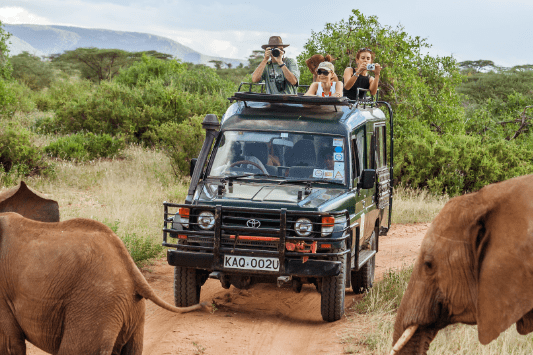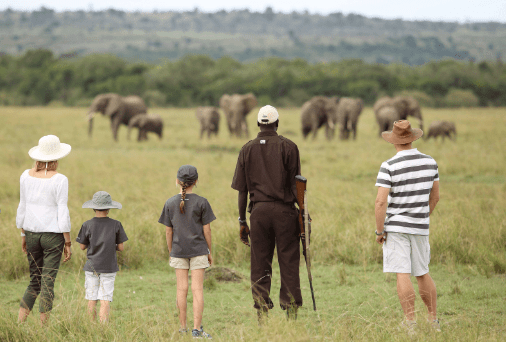Safari adventures in Kenya offer an unparalleled opportunity to witness the wild in its natural habitat. The right clothing is more than just a matter of comfort—it’s a strategic choice that enhances your safari experience. Dressing appropriately for the climate, terrain, and local customs is crucial to ensure an enjoyable and memorable trip.
When embarking on a safari adventure in Kenya, the key to a successful and enjoyable experience lies in choosing the right clothing. The Kenyan climate, characterized by diverse weather patterns, demands lightweight and breathable attire, such as loose-fitting shirts and long pants for protection against the sun and insects. Neutral and earth-tone colors, like khaki and brown, are preferable to blend into the natural surroundings and minimize wildlife disturbance.
Sturdy closed-toe shoes or hiking boots provide essential foot support for traversing various terrains, while accessories like binoculars, cameras, and reusable water bottles enhance the safari experience. Cultural sensitivity also plays a vital role, prompting the choice of modest clothing when engaging with local communities. Overall, selecting the appropriate clothing ensures comfort, protection, and respectful engagement with both the environment and the people encountered during the safari journey in Kenya.
Understanding the Climate and Terrain
Kenya’s climate varies widely, so understanding the weather patterns and seasonal changes is key to packing appropriate clothing. The country experiences a diverse climate, from the hot and dry conditions of the savannah to the more temperate climates in higher altitudes. Layers are essential, allowing you to adjust to temperature fluctuations as the day progresses and as you explore different terrains.
The safari terrains in Kenya encompass vast savannahs, grasslands, forests, and more. Each habitat presents unique challenges and opportunities. Therefore, being prepared with suitable clothing for each type of terrain is crucial for a successful and comfortable safari.

Safari Clothing Essentials
When it comes to clothing, lightweight and breathable fabrics are your best friends on a Kenyan safari. Loose-fitting tops and shirts made of natural fibers like cotton keep you cool and comfortable in the heat. Pair these with long pants to protect against the sun and potential insect bites. Additionally, packing a mix of long-sleeved and short-sleeved shirts allows flexibility in adjusting to the climate.
Neutral and earth-tone colors, such as khaki, olive, and brown, are ideal choices for blending into the natural surroundings. These colors also help minimize disturbances to wildlife and make for better wildlife viewing experiences. Choose clothing with pockets for easy access to essentials during the safari. Lastly, consider insect-repellent clothing to protect yourself from bites during your outdoor adventures.
Here is a list of some of the best clothing items to pack for a Kenyan safari:
- Long-Sleeved Shirts and Tops: Lightweight and breathable, these protect against the sun and insects.
- Shorts and Long Pants: Ideal for hot days and provide coverage against sun exposure and potential insect bites.
- Neutral and Earth-Tone Colors: Khaki, brown, olive, and similar colors blend into the environment and avoid startling wildlife.
- Wide-Brimmed Hat and Sunglasses: Provide shade and protect from the sun’s glare during game drives.
- Insect-Repellent Clothing: Garments treated with insect repellent for added protection against bites.
- Layering Options: Lightweight jackets or sweaters for cooler mornings or evenings.
- Swimwear: If your safari includes locations with swimming facilities.
- Undergarments: Enough for the duration of your safari, prioritizing comfort and functionality.
- Rain Gear: Lightweight, packable rain jacket or poncho for unexpected rain showers.
- Gloves and Scarf: Useful for cooler temperatures, especially in early mornings and evenings.
- Cultural-Appropriate Attire: Modest clothing for visits to local communities or villages.
- Safari Vest or Jacket with Pockets: Convenient for carrying essentials during game drives.
Remember to choose lightweight, breathable, and moisture-wicking fabrics for optimal comfort during your safari adventure in Kenya.
Safari Footwear
Proper footwear is paramount for a successful safari experience. Sturdy and comfortable closed-toe shoes, like hiking boots or walking shoes, provide ample support and protection during bushwalks or game drives. Hiking boots with good grip are recommended, especially if you plan on participating in walking safaris. However, keep in mind that comfort should not be compromised—opt for footwear that allows you to explore for extended periods without discomfort.
For downtime at the lodge or during a relaxed evening, a pair of comfortable sandals or flip-flops can provide relief and let your feet breathe. Having the right footwear ensures you are prepared for varying activities and terrains while keeping your feet comfortable throughout the journey.
Here’s a list of some of the best footwear options for a Kenyan safari:
- Sturdy Closed-Toe Shoes: Durable shoes with a closed-toe design to protect your feet and provide stability during game drives and walks.
- Hiking Boots: Sturdy boots with good grip, ankle support, and protection for walks and hikes, especially if your safari includes walking safaris or trekking.
- Trail Running Shoes: Lightweight yet durable shoes suitable for various terrains encountered during safari activities.
- Safari Boots: Specifically designed for safari adventures, these provide comfort, protection, and traction for long days of wildlife viewing.
- Sandals or Flip-Flops: Comfortable options for downtime at the lodge or relaxing evenings.
- Waterproof Boots or Shoes: Essential for safaris during the rainy season or in areas with water crossings.
- Socks: Pack moisture-wicking, comfortable socks suitable for the activities and climate of your safari.
Choose footwear that is comfortable, suitable for the specific activities you’ll be engaging in, and provides adequate support and protection for your feet while allowing you to enjoy the unique experiences of a Kenyan safari.

Safari Accessories and Gear
Enhance your safari experience by packing essential accessories and gear. A good pair of binoculars is a must for wildlife viewing, allowing you to observe animals in their natural habitat from a safe distance. A camera with appropriate lenses and spare batteries is vital for capturing those unforgettable safari moments. Additionally, carrying a lightweight backpack to hold your essentials, like sunscreen, a hat, and snacks, is practical and convenient.
Staying hydrated is crucial, so carrying a reusable water bottle is highly recommended. Many safari operators emphasize sustainability, so using a refillable bottle not only helps you stay refreshed but also reduces plastic waste during your trip.
Here’s a list of some necessary safari accessories and gear to enhance your safari experience:
- Binoculars: Essential for wildlife viewing, allowing you to observe animals in their natural habitat from a safe distance.
- Camera and Lenses: Capture memorable moments and stunning wildlife with a good quality camera and appropriate lenses.
- Spare Camera Batteries and Memory Cards: Ensure you have enough power and storage for all the photo opportunities during your safari.
- Lightweight Backpack: Ideal for carrying essentials such as sunscreen, a hat, snacks, and a water bottle during game drives.
- Reusable Water Bottle: Stay hydrated throughout the day by carrying a refillable water bottle to minimize plastic waste.
- Headlamp or Flashlight: Useful for navigating around the campsite or lodge after dark and during nighttime excursions.
- Power Bank: Ensure your electronic devices stay charged, especially if you plan to use your phone for photography or navigation.
- Power Adapters and Converters: Depending on your destination, these are essential to charge your devices.
- Safari Vest or Jacket with Pockets: Convenient for carrying essentials, such as your camera, binoculars, and sunscreen, during game drives.
- Sunglasses: Protect your eyes from the harsh sun and glare, especially during daytime game drives.
- Sunscreen and Lip Balm: Protect your skin and lips from the strong African sun.
- First Aid Kit: Include basic medical supplies for minor injuries or ailments.
- Insect Repellent: Keep pesky insects at bay, particularly during evening and nighttime activities.
- Hat or Cap: Shield yourself from the sun and keep cool during game drives.
- Travel Adapters: Ensure you can plug in and charge your devices with the appropriate outlets used in Kenya.
Having these essential safari accessories and gear will not only make your safari comfortable and convenient but also enhance your ability to capture and enjoy the breathtaking sights and experiences of Kenya’s wildlife and landscapes.
Cultural Sensitivity When Dressing for a Safari
Respecting local customs and traditions is essential when traveling to any destination, and Kenya is no exception. While comfort and practicality are key factors in choosing your safari attire, it’s important to dress modestly and respectfully, especially when visiting local communities or villages. Avoid overly revealing clothing and opt for more conservative choices to adhere to cultural norms and show respect to the people you encounter.
Understanding and acknowledging the cultural sensitivities of the region you are visiting is a sign of a responsible and considerate traveler. By dressing appropriately, you demonstrate an understanding and appreciation of the local culture.

Packing Tips
Packing light and efficiently is a skill that can greatly enhance your safari experience. Roll your clothes instead of folding them; this saves space and minimizes wrinkles. Pack only what you need and stick to the essentials—clothing for different weather conditions, appropriate footwear, necessary accessories, and personal hygiene items.
Make a checklist of items to ensure you have everything you need, and double-check it before you depart. If you’re uncertain about what to bring, consult your safari operator or do thorough research to make sure you’re well-prepared for your adventure.
Wrapping Up
Preparing for a safari in Kenya involves thoughtful consideration of what to wear to ensure comfort, functionality, and cultural sensitivity. Understanding the climate and terrains, packing appropriate clothing and footwear, and respecting local customs are essential aspects of a successful safari experience. By following these guidelines and being mindful of the impact of your choices, you can fully immerse yourself in the awe-inspiring beauty of Kenya’s wildlife and landscapes.
Frequently Asked Questions
What not to wear on a safari in Kenya?
Avoid bright and flashy colors that may startle wildlife. Refrain from wearing strong scents, as they can attract insects and potentially disturb animals. Additionally, steer clear of revealing or provocative clothing, respecting both cultural norms and practicality in the safari environment.
What colors to wear on safari in Kenya?
Neutral and earth-tone colors such as khaki, brown, green, and olive are ideal. These colors blend into the natural surroundings, minimize disturbances to wildlife, and enhance your overall safari experience.
What is the best clothing to wear on safari?
Lightweight and breathable clothing made of natural fibers like cotton is recommended. Loose-fitting tops, long pants, shorts, and comfortable footwear are essential. Layering options for temperature fluctuations and insect-repellent clothing can further enhance your comfort and protection during the safari.
Is there a dress code for safari?
While there’s no strict dress code, it’s important to dress comfortably and in a manner that respects local cultures. Choose practical, modest, and neutral-colored clothing that suits the climate and activities of a safari while adhering to cultural norms.










I don’t think the title of your article matches the content lol. Just kidding, mainly because I had some doubts after reading the article. https://accounts.binance.info/da-DK/register?ref=V3MG69RO
https://t.me/officials_pokerdom/3532
https://t.me/s/site_official_1win/636
Your blog is a treasure trove of valuable insights and thought-provoking commentary. Your dedication to your craft is evident in every word you write. Keep up the fantastic work!
https://t.me/mcasino_martin/690
https://shorturl.fm/I33z1
https://shorturl.fm/mgzjJ
https://t.me/s/ef_beef
https://shorturl.fm/qzi7H
[url=https://vavadacasinos.neocities.org/]вавада[/url] — это актуальное зеркало для доступа к популярному онлайн-казино.
Она предлагает широкий выбор слотов, рулетки и карточных игр.
Сайт отличается удобным интерфейсом и быстрой работой. Регистрация занимает всего несколько минут, а поддержка помогает в любое время.
#### Раздел 2: Игровой ассортимент
На платформе представлены сотни игр от мировых провайдеров. Каждый игрок найдет вариант по вкусу — от блекджека до современных видео-слотов.
Особого внимания заслуживают джекпоты и турниры. Крупные выигрыши разыгрываются в прогрессивных слотах.
#### Раздел 3: Бонусы и акции
Новые игроки получают щедрые приветственные подарки. Вращения в слотах дарятся без обязательных вложений.
Система лояльности поощряет постоянных клиентов. Чем чаще вы играете, тем выше становятся бонусы.
#### Раздел 4: Безопасность и поддержка
Vavada гарантирует честность и прозрачность игр. Все автоматы проходят проверку на случайность генерации чисел.
Служба поддержки работает в режиме 24/7. Игроки могут связаться с поддержкой через email или мессенджеры.
### Спин-шаблон
#### Раздел 1: Введение в мир Vavada
1. Vavada — известный ресурс для любителей азартных развлечений.
2. Она предлагает широкий выбор слотов, рулетки и карточных игр.
3. Сайт отличается удобным интерфейсом и быстрой работой.
4. Игроки могут зайти на платформу как с компьютера, так и со смартфона.
#### Раздел 2: Игровой ассортимент
1. Ассортимент включает в себя множество игр от топовых студий.
2. Здесь есть классические слоты, настольные игры и live-дилеры.
3. Крупные розыгрыши привлекают внимание тысяч участников.
4. Специальные акции увеличивают шансы на победу.
#### Раздел 3: Бонусы и акции
1. Регистрация открывает доступ к выгодным бонусам.
2. Вращения в слотах дарятся без обязательных вложений.
3. Чем больше вы играете, тем выгоднее становятся условия.
4. Кешбэк и эксклюзивные предложения доступны для VIP-игроков.
#### Раздел 4: Безопасность и поддержка
1. Игровой процесс строго контролируется независимыми аудиторами.
2. Все автоматы проходят проверку на случайность генерации чисел.
3. Служба поддержки работает в режиме 24/7.
4. Игроки могут связаться с поддержкой через email или мессенджеры.
https://shorturl.fm/K8e75
https://shorturl.fm/PXNnR
https://t.me/of_1xbet/987
Can you be more specific about the content of your article? After reading it, I still have some doubts. Hope you can help me. https://accounts.binance.com/uk-UA/register?ref=XZNNWTW7
https://shorturl.fm/TWeLf
[url=https://dzialki-beskidy.pl/]vavada casino pl[/url]
Posiadanie ziemi w Beskidach zapewnia nie tylko spokoj, ale takze mozliwosc atrakcyjnego zarobku w przyszlosci.
Dzieki rozwijajacej sie infrastrukturze i rosnacemu zainteresowaniu turystow, ceny dzialek stopniowo wzrastaja. Region ten przyciaga milosnikow gorskich wedrowek i aktywnego wypoczynku.
#### **2. Gdzie szukac najlepszych ofert dzialek?**
Wybor odpowiedniej lokalizacji zalezy od indywidualnych potrzeb i budzetu. Najlepsze propozycje mozna znalezc na specjalistycznych serwisach, gdzie dostepne sa dzialki o roznej powierzchni i standardzie.
Przed zakupem nalezy dokladnie przeanalizowac dostepnosc mediow i warunki zabudowy. Niektore tereny wymagaja dodatkowych formalnosci, dlatego warto skorzystac z pomocy ekspertow.
#### **3. Jakie korzysci daje posiadanie dzialki w Beskidach?**
Nieruchomosc w gorach to nie tylko inwestycja finansowa, ale rowniez szansa na poprawe jakosci zycia. Wlasny kawalek ziemi w gorach pozwala na realizacje marzen o spokojnym zyciu z dala od zgielku miasta.
Dodatkowo, region ten oferuje wiele atrakcji, takich jak szlaki turystyczne i stoki narciarskie. Wlasciciele dzialek moga korzystac z licznych festiwali i wydarzen kulturalnych organizowanych w regionie.
#### **4. Jak przygotowac sie do zakupu dzialki?**
Przed podjeciem decyzji warto skonsultowac sie z prawnikiem i geodeta. Dobrze jest sprawdzic historie nieruchomosci i upewnic sie, ze nie ma zadnych obciazen.
Wazne jest rowniez okreslenie swojego budzetu i planow zwiazanych z zagospodarowaniem terenu. Wiele osob decyduje sie na kredyt, aby sfinansowac zakup wymarzonej dzialki.
—
### **Szablon Spinu**
**1. Dlaczego warto kupic dzialke w Beskidach?**
– Malownicze krajobrazy Beskidow przyciagaja zarowno turystow, jak i przyszlych mieszkancow.
– Dzieki rozwojowi infrastruktury, tereny te staja sie jeszcze bardziej atrakcyjne.
**2. Gdzie szukac najlepszych ofert dzialek?**
– Profesjonalne agencje nieruchomosci czesto oferuja najlepsze propozycje w regionie.
– Warto porownac rozne oferty, aby znalezc najbardziej oplacalna inwestycje.
**3. Jakie korzysci daje posiadanie dzialki w Beskidach?**
– Wlasny kawalek gorskiej przestrzeni pozwala na ucieczke od miejskiego zgielku.
– Coraz wiecej osob docenia walory turystyczne i rekreacyjne Beskidow.
**4. Jak przygotowac sie do zakupu dzialki?**
– Warto dokladnie sprawdzic historie dzialki, aby upewnic sie, ze nie ma zadnych roszczen.
– Okreslenie budzetu i celow inwestycji ulatwi podjecie wlasciwej decyzji.
Really insightful post — Your article is very clearly written, i enjoyed reading it, can i ask you a question? you can also checkout this newbies in classied. iswap24.com. thank you
Really insightful post — Your article is very clearly written, i enjoyed reading it, can i ask you a question? you can also checkout this newbies in classied. iswap24.com. thank you
Really insightful post — Your article is very clearly written, i enjoyed reading it, can i ask you a question? you can also checkout this newbies in classied. iswap24.com. thank you
https://shorturl.fm/iZc90
https://t.me/s/reyting_topcazino/13
Your point of view caught my eye and was very interesting. Thanks. I have a question for you.
https://t.me/iGaming_live/4705
Discover exquisite Austrian wines at [url=https://wine-tasting-wien.netlify.app/]wine tour vienna[/url] and immerse yourself in Vienna’s vibrant wine culture.
In Wien kann man die Vielfalt osterreichischer Weine auf besondere Weise entdecken. Die Region ist bekannt fur ihren exzellenten Wei?wein, besonders den Grunen Veltliner. Jahrlich stromen Tausende von Besuchern in die Weinkeller der Stadt.
Das milde Klima und die mineralreichen Boden begunstigen den Weinbau. Das gibt den Wiener Weinen ihren unverwechselbaren Charakter.
#### **2. Beliebte Weinregionen und Weinguter**
In Wien gibt es mehrere renommierte Weinregionen, wie den Nussberg oder den Bisamberg. Die Weinguter hier setzen auf nachhaltigen Anbau. Familiengefuhrte Weinguter bieten oft Fuhrungen und Verkostungen an. Gaste konnen die Leidenschaft der Winzer hautnah erleben.
Ein Besuch im Weingut Wieninger oder im Mayer am Pfarrplatz lohnt sich. Sie sind bekannt fur ihre ausgezeichneten Jahrgange.
#### **3. Ablauf einer typischen Weinverkostung**
Eine klassische Wiener Weinverkostung beginnt meist mit einer Kellertour. Oft werden historische Anekdoten zum Weinbau geteilt. Danach folgt die Verkostung unterschiedlicher Weine. Die Aromen werden von den Experten detailliert beschrieben.
Haufig werden die Weine mit lokalen Kasesorten oder Brot serviert. Es ist die perfekte Erganzung zum sensorischen Erlebnis.
#### **4. Tipps fur unvergessliche Weinverkostungen**
Um das Beste aus einer Weinverkostung in Wien herauszuholen, sollte man vorher buchen. Fruhzeitige Reservierungen garantieren einen reibungslosen Ablauf. Zudem lohnt es sich, auf die Jahreszeiten zu achten. Die warmen Monate eignen sich perfekt fur Verkostungen im Freien.
Ein guter Tipp ist auch, ein Notizbuch mitzubringen. So kann man sich die geschmacklichen Eindrucke leicht merken.
—
### **Spin-Template fur den Artikel**
#### **1. Einfuhrung in die Weinverkostung in Wien**
Das gibt den Wiener Weinen ihren unverwechselbaren Charakter.
#### **2. Beliebte Weinregionen und Weinguter**
Hier verbinden sich Tradition mit innovativen Methoden.
#### **3. Ablauf einer typischen Wiener Weinverkostung**
Jeder Wein wird sorgfaltig prasentiert und verkostet.
#### **4. Tipps fur unvergessliche Weinverkostungen**
Es hilft, personliche Favoriten zu dokumentieren.
—
**Hinweis:** Durch Kombination der Varianten aus den -Blocken konnen zahlreiche einzigartige Texte generiert werden, die grammatikalisch und inhaltlich korrekt sind.
https://shorturl.fm/SAcM2
https://t.me/s/iGaming_live/4627
Актуальные рейтинги лицензионных онлайн-казино по выплатам, бонусам, минимальным депозитам и крипте — без воды и купленной мишуры. Только площадки, которые проходят живой отбор по деньгам, условиям и опыту игроков.
Следить за обновлениями можно здесь: https://t.me/s/reitingcasino
https://shorturl.fm/iWXMm
Entdecken Sie die besten Weinverkostungen in Wien auf [url=https://weinverkostung.neocities.org/]weinverkostung wien heute[/url].
Die osterreichische Hauptstadt bietet eine einzigartige Mischung aus Tradition und Moderne.
Die Weinverkostungen in Wien sind perfekt fur Kenner und Neulinge. Viele Veranstaltungen werden von erfahrenen Sommeliers begleitet.
#### **2. Die besten Orte fur Weinverkostungen**
In Wien gibt es zahlreiche Lokale und Weinguter, die Verkostungen anbieten. Das Weinmuseum im Stadtzentrum ist ein idealer Ausgangspunkt fur Weinliebhaber.
Einige Winzer veranstalten Fuhrungen durch ihre Kellereien. Zusatzlich konnen Gaste direkt beim Erzeuger kosten.
#### **3. Wiener Weinsorten und ihre Besonderheiten**
Wiener Weine sind vor allem fur ihre Vielfalt bekannt. Der beliebte Gemischte Satz ist eine lokale Spezialitat, die aus mehreren Traubensorten besteht.
Die Bodenbeschaffenheit und das Klima pragen den Geschmack. Die mineralischen Noten der Wiener Weine sind besonders ausgepragt.
#### **4. Tipps fur eine gelungene Weinverkostung**
Eine gute Vorbereitung macht die Verkostung noch angenehmer. Ein neutraler Geschmack im Mund vor der Verkostung verbessert das Erlebnis.
Gruppenverkostungen bringen zusatzlichen Spa?. Gemeinsames Diskutieren uber die Aromen fordert den Austausch.
—
### **Spin-Template fur den Artikel**
#### **1. Einfuhrung in die Weinverkostung in Wien**
Wien ist nicht nur fur seine historischen Sehenswurdigkeiten bekannt, sondern auch fur seine lebendige Weinkultur.
#### **2. Die besten Orte fur Weinverkostungen**
Das Weinmuseum im Stadtzentrum ist ein idealer Ausgangspunkt fur Weinliebhaber.
#### **3. Wiener Weinsorten und ihre Besonderheiten**
Die Bodenbeschaffenheit und das Klima pragen den Geschmack.
#### **4. Tipps fur eine gelungene Weinverkostung**
Viele Veranstalter bieten thematische Verkostungen an.
https://t.me/pt1win/96
https://shorturl.fm/KNqGP
Thank you for your sharing. I am worried that I lack creative ideas. It is your article that makes me full of hope. Thank you. But, I have a question, can you help me?
Can you be more specific about the content of your article? After reading it, I still have some doubts. Hope you can help me.
Great article! I really appreciate the clear insights you shared – it shows true expertise. As someone working in this field, I see the importance of strong web presence every day. That’s exactly what I do at https://webdesignfreelancerhamburg.de/ where I help businesses in Hamburg with modern, conversion-focused web design. Thanks for the valuable content!
Thanks for sharing. I read many of your blog posts, cool, your blog is very good.